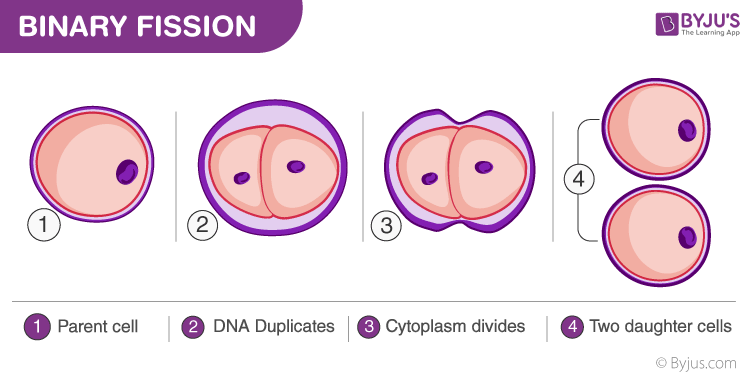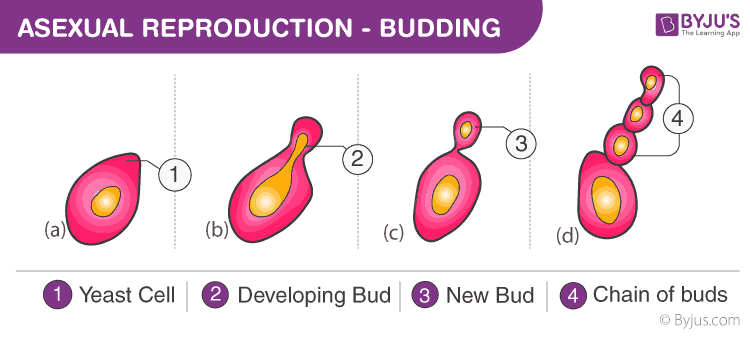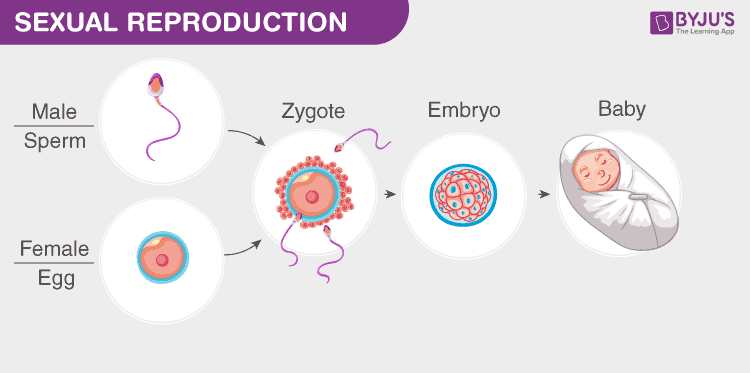Find below the important notes for the chapter, Reproduction in Organisms, as per NEET Biology syllabus. This is helpful for aspirants of NEET and other exams during last-minute revision. Important notes for NEET Biology- Reproduction in Organisms covers all the important topics and concepts useful for the exam. Check BYJU’S for the full set of important notes and study material for NEET Biology and solve the NEET Biology MCQs to check your understanding of the subject.
Download Complete Chapter Notes of Reproduction in Organisms
Download Now
| Name of the NEET sub-section | Topic | Notes helpful for |
| Biology | Reproduction in Organisms | NEET exams |
Reproduction in Organisms – Important Points, Summary, Revision, Highlights
Table of Contents
Reproduction in Organisms
Recommended Videos:


Reproduction is the process by which an organism multiplies and gives birth to another organism of the same kind. Reproduction is important for maintaining diversity and perpetuation of a race as every individual has a limited life span.
Reproduction is required for the continuity of the gene pool and also to get genetic variations, which get inherited to the offspring.
Asexual reproduction is the process of generating offspring from a single parent.
Sexual reproduction is the process, where there is an involvement of opposite sexes and offspring are produced by the fusion of male and female gametes.
Asexual reproduction
- Each individual is capable of multiplying
- The offspring produced is morphologically and genetically identical or a clone of the parent
- Asexual reproduction does not lead to genetic variations
- It is common in microorganisms, unicellular and simple plants and animals
There are various methods of asexual reproduction:
- Binary Fission: It is a common method of replication in unicellular (Monera, Protista). The cell divides into two halves and multiplies. First, the nucleus divides and then followed by the cytoplasm. The daughter cells are genetically identical as they are formed after mitotic division. Sometimes nucleus divides amitotically, giving rise to multiple nuclei without cytoplasmic division, later cytoplasm accumulates around each nucleus giving rise to many offspring. This is known as multiple fission e.g. Paramecium, Amoeba.Examples: Simple binary fission- Amoeba, Longitudinal binary fission- Euglena, Transverse binary fission- Paramecium.
- Budding: Buds are formed due to unequal division and they remain attached to the parent. After maturation, they get separated. Examples: Yeast, Hydra, etc.
- Fragmentation: This is a common method of reproduction in many algae and fungi. The body breaks into pieces and each fragment develops into a new individual. Examples: Spirogyra, Ulothrix, Rhizopus, etc. Starfish, Planaria, Hydra also reproduce by fragmentation.
- Spore formation: Asexual spore formation takes place in special structures in various algae, fungi, protozoa, etc. under unfavourable conditions. These spores may be motile or non-motile. They develop into a new individual when the favourable conditions return. Examples: Amoeba forms three-layered cyst (encystation) to escape unfavourable conditions. When conditions are favourable, they undergo multiple fissions and form many pseudopodiospores. The cyst wall bursts open (sporulation), the spores are released and they form multiple amoebae.Zoospores (motile) are formed in Chlamydomonas, Ulothrix, Oedogonium, Sporangiospores and chlamydospores- RhizopusConidia (non-motile) in Penicillium, Gemmules- Sponges, Aplanospores (non-motile)- Ulothrix, Akinetes (non-motile)- Nostoc
- Vegetative propagation in plants: Many plants are propagated from vegetative parts. These are known as vegetative propagules. Mostly they contain nodes, which on contact with the soil and nutrients, develop roots and form a new plantlet. Examples: Runner- lawn grass, Suckers- mint, Germinating eye buds- potato, Leaf- Bryophyllum, Offset- Eichornia, Bulbil- Agave, Rhizome- banana, ginger, roots- Dahlia, sweet potato.Water hyacinth is known as “Terror of Bengal”. It grows rapidly and drains oxygen from water, leading to the death of fish.Many plants are artificially grown by vegetative methods as it is easier and faster. It is commercially a more productive method. Artificial methods are cutting, grafting, layering and tissue culture.Cutting of stem with nodes- Rose, sugarcane; cutting of root- lemon and tamarind.

Grafting- Fruit trees like apple, mango, guava.
Layering- Plants with flexible stems, e.g. raspberries, blackberries, etc.




Sexual Reproduction
Sexual reproduction is common in higher plants and animals. Simple algae, fungi also shift to sexual reproduction at the onset of adverse conditions. Conjugation in Paramecium, a unicellular protozoan is a rudimentary sexual reproduction.

In sexual reproduction male and female gametes fuse to form a zygote after fertilization. The zygote develops into a new individual, which is not identical but similar to the parents.
All the organisms have to reach a certain stage of growth and maturity to start reproducing sexually.
Plants show a distinct reproductive phase. Some are annual or biennial or perennial.
Bamboo- flowers once.
Neelakurunji (Strobilanthus kunthiana)- flowers once in 12 years.
Animals also reproduce sexually at certain stages. Many birds lay eggs seasonally. Placental animals show cyclic changes during reproductive phases. E.g. Oestrous cycle in cows, sheep, dogs, tigers, etc. Menstrual cycle in primates.
Male and female reproductive structures can be present on the same plant or animal (Bisexual) or different plants or animals (Unisexual).
Bisexual is the same as homothallic or monoecious and Unisexual is also termed as heterothallic or dioecious in many fungi, plant and animal species.
Monoecious plants: Coconut, Cucurbit, Chara, etc.
Dioecious plants: Papaya, Date palm, Marchantia, etc.
Bisexual flower: Sweet potato, sweet pea, Hibiscus, Lily, Rose, etc.
Unisexual flower: Papaya, watermelon, maize, bitter gourd, coconut, etc.
Monoecious or hermaphrodite animals: Earthworm, leeches, sponges, flatworms, etc.
Dioecious: Cockroaches and other higher animals.
Some of the organisms are haploid, i.e. have only one set of the chromosomes in their body, e.g. algae, fungi, bryophytes.
Most of the animals and pteridophytes, gymnosperms and angiosperms are diploid, i.e. they contain 2 sets of chromosomes. They produce haploid gametes by meiosis or reduction division.
Sexual reproduction can be divided into pre-fertilization, fertilization and post-fertilization stages.
1. Pre-fertilization
a. Gametogenesis (Gamete formation): Gametes are haploid.
Isogametes or homogametes- male and female gametes are similar in appearance, e.g. an alga, Cladophora.
Heterogametes- morphologically distinct male and female gametes are produced in most of the organisms, e.g. an alga, Fucus, human beings.
Male gamete- antherozoids or sperm
Female gamete- egg or ovum
b. Gamete transfer (Pollination): In most of the organisms male gamete is motile and swims towards female gamete. Algae, fungi and plants (bryophytes, pteridophytes) require water as a medium for the movement of gametes.
In higher plants, pollen grains are transferred to stigma by the process of pollination. Bisexual flowers are self-fertilized as stigma and anther are present close by. Cross-pollinating flowers need a pollinating agent, e.g. wind, insect, etc.
Dioecious animals have special mechanisms for the gamete transfer.
2. Fertilization
Fertilization is also known as syngamy. In this process, a diploid zygote is formed after the fusion of male and female gametes.
External fertilization: When gametes fuse externally. Offspring produced by external fertilization are vulnerable to predators, e.g. algae, fishes, amphibians.
Internal fertilisation: In higher plants and animals, fertilisation takes place internally in the female body.
3. Post-fertilization
a. Zygote: After fertilization diploid zygote is formed. The zygote undergoes further division and develops into a new organism.
In algae and fungi, the zygote forms a thick wall around itself to resist desiccation and damage and germinates only after a resting period when favourable conditions return.
In organisms with a haplontic life cycle (haploid dominant phase), the zygote undergoes meiosis to form haploid spores and a new haploid organism is formed.
b. Embryogenesis (Embryo development): It is the process of development of an embryo from a zygote. The zygote undergoes cell division and differentiation.
Cell division: Cell number and mass increases.
Cell differentiation: Cells undergo modification to form specific tissues and organs.
Oviparous: Egg-laying animals. A fertilized egg is laid outside, which is covered by a hard calcareous shell. The young one hatches out after a period of incubation. E.g. Reptiles, birds, etc.
Viviparous: Giving birth to young ones. Embryogenesis is inside the female body and young ones are delivered out. Different animals have a different gestation period.
In angiosperms, the zygote develops inside the ovule and develops into the embryo.
Ovule- Seed
Ovary- Fruit
Seeds develop a protective covering called pericarp and get dispersed. They germinate into a new plant after getting a suitable medium and conditions.
In human beings, the zygote undergoes cleavages to form blastula and then after gastrulation three primary germinal layers are formed, i.e. ectoderm, endoderm and mesoderm. These three germinal layers differentiate into all the specific tissues and organs.
Parthenogenesis: Development of a new organism without fertilization, e.g. in honeybees, sterile drones are haploid (n=16) and develop from the female gametes. Other examples include lizards, turkey, rotifers, etc.
Parthenocarpy is artificially induced in some plants to get seedless fruits.
Explore the next chapter for important points with regards to NEET, only at BYJU’S. Check the NEET Study Material for all the important concepts and related topics.
Also see:
NEET Flashcards: Reproduction In Organisms
NEET Flashcards: Sexual Reproduction In Flowering Plants
NEET Flashcards: Human Reproduction
NEET Flashcards: Reproductive Health
NEET Flashcards: Principles Of Inheritance And Variation


Comments